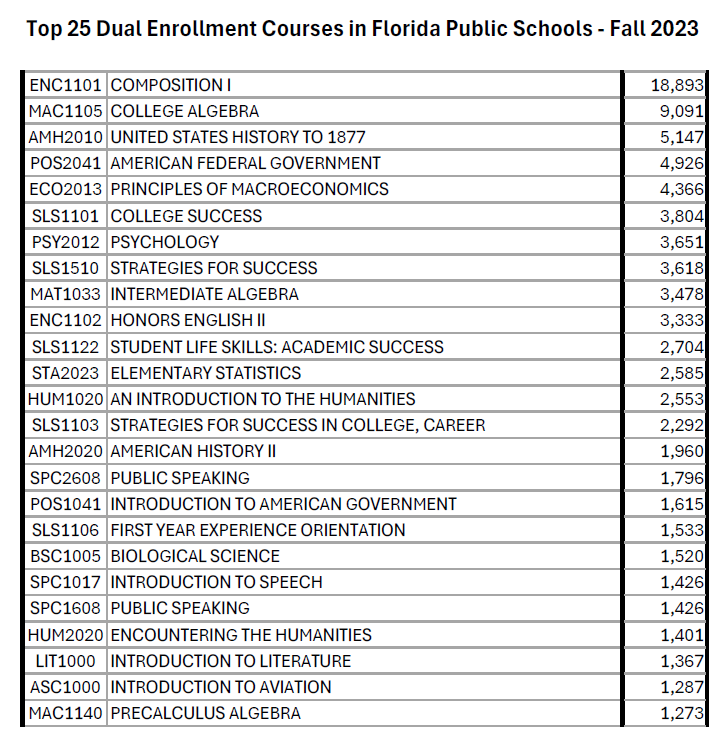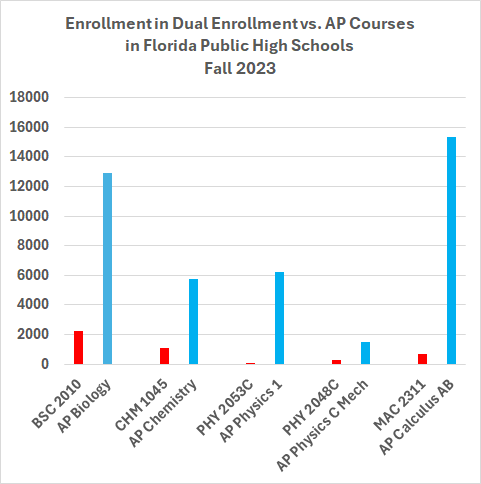An outside observer might expect that Florida’s aggressive program to dual enroll public high school students in college classes, and in many cases have them awarded A.A. degrees at the same time they receive their high school diplomas, would be good for the state’s pipeline to bachelor’s degree-level STEM careers. But course enrollment statistics recently released by the Florida Department of Education reveal that the dual enrollment program doesn’t make a significant contribution to the Florida’s STEM pipeline.
The 25 most-dual enrolled college courses (a table is shown below) are generally courses that satisfy the state’s general education requirements. The course most dual-enrolled by far in the Fall of 2023 (data provided by the Florida Department of Education) was the first semester English composition class, ENC 1101. Second was College Algebra (MAC 1105), which is a math course that is much lower level than the first calculus course required for many STEM majors (MAC 2311). The only other math courses in the top 25 are Intermediate Algebra (MAT 1033) which is at a still lower level than College Algebra, and Precalculus Algebra (MAC 1140), which is also a course at a lower level than MAC 2311.
The only science course listed in the top 25 is the general education biology class, BSC 1005, although as I’ll explain below the first semester biology class for biology majors has a large enrollment that is masked by variations in course numbering schemes among state colleges.
The foundational science courses taken in college by students majoring in fields like the physical sciences and engineering are the two-semester introductory chemistry sequence, CHM 1045 and CHM 1046, and the two-semester calculus-based introductory physics sequence, PHY 2048C and PHY 2049C. The numbering scheme for these courses varies from institution to institution in the Florida College System. The first digit in the course numbers can be 1 or 2 or even the letter “C”. If I comb the enrollment numbers for these courses and add the enrollments from these different numbering schemes together, I arrive at enrollment totals of 1,124 for CHM 1045, 166 for CHM 1046, 280 for PHY 2048C and 21 for PHY 2049C.
The first two biology courses taken by students majoring in life and health sciences are BSC 2010 and BSC 2011. If I add up the enrollments in these courses over the different numbering schemes, I find 2,216 for BSC 2010 and 313 for BSC 2011. That total for BSC 2010 would put it in the top 25 and would make it the only science course for science majors in the top 25.
It’s also worth addressing the two-semester introductory physics sequence for life and health science majors, PHY 2053C and PHY 2054C. PHY 2053C enrolled only 80 students, while PHY 2054C enrolled only 15.
A few paragraphs ago, I mentioned the first calculus course for STEM majors, MAC 2311. If I once again sum over the different course numbering schemes, I arrive at a total enrollment of 716. The second course in the calculus sequence, MAC 2312, enrolled 357.
In math and science courses for aspiring STEM majors, Advanced Placement course remain much more popular than dual enrollment courses. In the plot below, enrollments in dual enrollment courses are compared to those of the corresponding AP courses. Outside of math and science, the first semester college writing course, ENC 1101, which has the highest enrollment of any dual enrollment course at 18,893, is still far behind the AP equivalent, AP English Language and Composition, which had 29,202 students enrolled this past fall.


